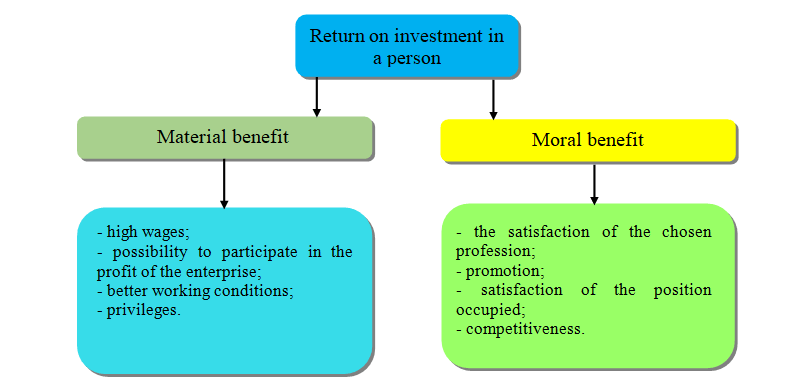Abstract
Content
- INTRODUCTION
- 1. THEORETICAL ASPECTS OF THE STAFF DEVELOPMENT
- 2. FOREIGN EXPERIENCE IN STAFF DEVELOPMENT
- 2.1 Staff development in Japan
- 2.2 Staff development in UA
- Conclusions
- References
INTRODUCTION
Staff development is a systematic process, oriented on the formation of the employees that are suitable for the enterprise, and at the same time on the study and development of the production and educational potential of the enterprise's employees.
Goal: to give the basic conceptual apparatus concerning the staff development in an enterprise.
In order to reach the established goal, we need to solve the following tasks:
– Give a definition of the term "staff development";
– Formulate the main goals of the staff development;
– Characterise the staff re-education and training;
– Consider the foreign experience.
The main object of the research is the potential of the organization, while the subject can be either the employee themselves or the employer as a special organizational executive structure.
The relevance of the subject is proven by the fact that the staff development is one of the most important areas of personnel management activities and factors in the successful operation of the enterprise.
1. THEORETICAL ASPECTS OF THE STAFF DEVELOPMENT
Staff development is a system of interconnected action that include strategy development, forecasting and planning of the requirements from the staff, management of their career and professional development and organization of their adaptation, education, training and formation of the corporate culture [1, p. 480].
Managers have to develop the professional thinking patterns of their subordinates, search for new business directions and ways to optimize the production processes in the interactions with customers. The real professionals of today are the people that solve their professional tasks in a systematic fashion.
Managing the staff development helps you to use each employee's potential in its fullness, improve their social and professional mobility, rebuild their technological and structural knowledge and increase their professional and intellectual value. As a result, socio-psychological climate at the workplace is improved, employee motivation increases and staff turnover slows down.

Figure 1.1 – Return on investment in people
2. FOREIGN EXPERIENCE IN STAFF DEVELOPMENT
2.1 Staff development in Japan
At the basis of the Japanese staff development lies the principle of the "human potential". This principle proposes that the most important factor is the ability of the employee to enjoy and be satisfied with heir work, develop their abilities and improve them.
The main task of the Japanese staff training system is to incorporate individual skills and build the team around them. Therefore, while a singular Japanese worker is usually less skilled than an American worker, a Japanese team is usually twice more efficient than an equally sized American team.
2.2 Staff development in UA
American companies are more concerned with educating and retraining their employees. Internal and external educational programs are actively encouraged, as well as long-distance and online educational resources. Large and innovative companies tend to create corporate universities. One of the tendencies of developing the corporate universities is allowing people from outside of the company to attend, which transforms the university into a profit center.
Almost every company has its own retraining system. New employees must go through the retraining annually, which means that the educational process is constant.
Conclusions
Current enterprises are facing new kinds of tasks, like developing an enterprise during an economic crisis and increasing the competitiveness and economic effectiveness of their production, which makes their stable operation all the more relevant and important.
Japanese and US enterprises offer an interesting experience of the internal education programs. We can even talk about an existence of the American and Japanese educational traditions based on decades of the experience and affecting every step of the staff development: from apprenticing in the workshops to training staff at the large modern enterprises.
References
- Беляцкий, Н. П. Управление персоналом : учеб. пособие для вузов / Н. П. Беляцкий, С. Е. Велесько, П. Ройш. – Минск : Экоперспектива, 2000. – 320 с.
- Веснин, В. Р. Управление персоналом : учеб. пособие / В. Р. Веснин. – М. : Велби : Проспект, 2008. – 240 с.
- Кибанов, А. Я. Управление персоналом : регламентация труда : учеб. пособие / А. Я. Кибанов, Г. А. Мамед-Заде, Т. А. Родкина ; под ред. А. Я. Кибанова ; Гос. ун-т упр. – 3-е изд., перераб. и доп. – М. : ЭКЗАМЕН, 2003. – 480 с. : табл., схем.
- Авдеев, В. В. Управление персоналом : технология формирования команды : учеб. пособие для вузов / В. В. Авдеев. – М. : Финансы и статистика, 2002. – 544 с.
- Пантелеева Е., Современный японский менеджмент: Управление персоналом / Е. Пантелеева, № 14, 2009.
- Зарубежный опыт развития персонала компании. [Электронный ресурс]. Режим доступа: http://hr-portal.ru/article/amerikanskaya-sistema...
- Развитие персонала. Электронный ресурс. Режим доступа: http://www.sbsc.ru/business...
- Обучение и развитие персонала. Электронный ресурс. Режим доступа: http://www.udbiz.ru...
- Зарубежный опыт развития персонала компании. Электронный ресурс. Режим доступа: http://www.managerline.ru/stmans...
